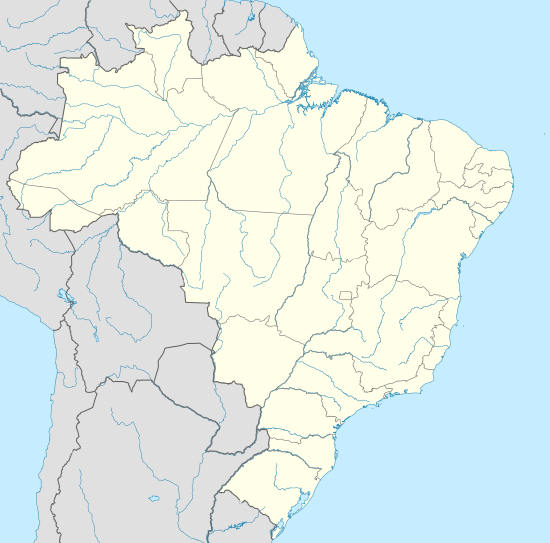2014 FIFA World Cup: Difference between revisions
BarnabyJoe (talk | contribs) →Venues: not very good with reflinks, but there's a good reference showing the stadium is completed |
|||
| Line 182: | Line 182: | ||
|Capacity: '''62,547''' |
|Capacity: '''62,547''' |
||
<small>(renovated)</small> |
<small>(renovated)</small> |
||
|Capacity: '''51,300'''<ref>{{cite web|url=http://www.internacional.com.br/pagina.php?modulo=16&setor=195&secao=&subsecao= |title=Site oficial do Sport Club Internacional – Projeto Gigante Para Sempre |publisher=Internacional.com.br |accessdate=25 May 2013 }}</ref><br /><small>(renovated) |
|Capacity: '''51,300'''<ref>{{cite web|url=http://www.internacional.com.br/pagina.php?modulo=16&setor=195&secao=&subsecao= |title=Site oficial do Sport Club Internacional – Projeto Gigante Para Sempre |publisher=Internacional.com.br |accessdate=25 May 2013 }}</ref><br /><small>(renovated)</small><ref>http://www.fifa.com/worldcup/news/newsid=2281119/index.html</ref><br /> |
||
|- |
|- |
||
|[[File:Novo mineirão aérea.jpg|200px]] |
|[[File:Novo mineirão aérea.jpg|200px]] |
||
Revision as of 02:07, 23 February 2014
| Copa do Mundo da FIFA Brasil 2014[nb 1] | |
|---|---|
 2014 FIFA World Cup logo | |
| Tournament details | |
| Host country | Brazil |
| Dates | 12 June – 13 July |
| Teams | 32 (from 5 confederations) |
| Venue(s) | 12 (in 12 host cities) |
← 2010 2018 → | |
The 2014 FIFA World Cup will be the 20th FIFA World Cup, an international men's football tournament, that is scheduled to take place in Brazil from 12 June to 13 July 2014.[1] It will be the second time that Brazil has hosted the competition, the previous being in 1950. Brazil was elected unchallenged as host nation in 2007 after the international football federation, FIFA, decreed that the tournament would be staged in South America for the first time since 1978 in Argentina, and the fifth time overall.
The national teams of 31 countries advanced through qualification competitions that began in June 2011 to participate with the host nation Brazil in the final tournament. A total of 64 matches are to be played in twelve cities across Brazil in either new or redeveloped stadiums, with the tournament beginning with a group stage. For the first time at a World Cup Finals, the matches will use goal-line technology.[2]
With the host country, all world champion teams since 1930 (Uruguay, Italy, Germany, England, Argentina, France and Spain) have qualified for this competition. Spain is the defending champion, having defeated the Netherlands 1–0 in the 2010 World Cup final to win its first World title. The previous four World Cups staged in South America were all won by South American teams.[3]
Host selection

On 7 March 2003, FIFA announced that the tournament would be held in South America for the first time since 1978, in line with its then-active policy of rotating the right to host the World Cup among different confederations.[4][5] The decision meant that it would be the first time that two consecutive World Cups will be staged outside Europe.
On 3 June 2003, the South American Football Confederation CONMEBOL initially announced that Argentina, Brazil, and Colombia wanted to host the finals.[6] but, by March 2004, the CONMEBOL associations had unanimously voted to adopt Brazil as their sole candidate.[7]
During the intervening months, Colombia decided that it would enter its own bid,[8] and formally declared its candidacy in December 2006.[9] A week earlier Brazil had also formally announced its interest.[10]
However, Colombia officially withdrew its bid in April 2007, leaving Brazil as the only host candidate.[11] On 30 October 2007 FIFA officially confirmed that Brazil would host the event.[12]
Qualification
The allocation of places for the final tournament was decided on 3 March 2011, with the distribution of the 31 places determined through the qualification process unchanged from that of the previous tournament.[13] The qualification draw for the 2014 World Cup was held at the Marina da Glória in Rio de Janeiro on 30 July 2011.[14][15] As the host nation, Brazil automatically qualified for the tournament.
203 of the 208 FIFA national teams at the time participated in the qualification stages, which began on 15 June 2011 and concluded on 20 November 2013. 24 of the 32 eventual qualifiers were present at the previous tournament, with the only debutant being Bosnia and Herzegovina, which qualified for the first time as an independent nation.[16] The highest-ranked absentee according to FIFA World Rankings will be Ukraine,[17] while the OFC region will have no representation at a World Cup Finals for the first time since 2002.
Qualified teams
The following 32 teams, shown with October 2013 rankings used for seeding in the draw,[18] qualified for the final tournament.
|
|
|
 Country qualified for the World Cup Country failed to qualify Country did not enter Country not a FIFA member
|
Venues

Eighteen locations were presented as potential World Cup host cities: Belém, Belo Horizonte, Brasília, Campo Grande, Cuiabá, Curitiba, Florianópolis, Fortaleza, Goiânia, Maceió, Manaus, Natal, Porto Alegre, Recife, Rio Branco, Rio de Janeiro, Salvador and São Paulo.[19]
FIFA proposes that no more than one city may use two stadiums, and the number of host cities is limited between eight and ten. The proposal of Ricardo Teixeira, the then-Head of the Brazilian Football Confederation, to use twelve host cities in "the interest of the whole country" was however accepted by FIFA in December 2008.[20]
The twelve host cities were announced on 31 May 2009, with Belém, Campo Grande, Florianópolis, Goiânia and Rio Branco being rejected;[21] Maceió had already withdrawn in January 2009. The twelve selections – each the capital of its state – cover all the main regions of Brazil and create more evenly distributed hosting than the 1950 finals in Brazil provided, when matches were concentrated in the south-east and south.[22] As a result the tournament will require significant long-distance travel for teams.[23]
A reported US$3.47 billion has been spent on stadium projects.[24] Five of the chosen host cities have brand new venues built specifically for the World Cup, while the Estádio Nacional Mané Garrincha in the capital Brasilia was demolished and rebuilt, and the remaining six are being extensively renovated.[25] The Estádio do Maracanã in Rio de Janeiro, which already holds the record attendance for a FIFA World Cup Finals match (199,854), is the largest of the stadiums and will stage the final. The CBF originally intended to host the opening match at São Paulo's Estádio do Morumbi but it was dropped in 2010 and replaced by the Arena Corinthians after failing to provide financial guarantees for the required improvements.[26]
The first new stadium, the Castelão, in Fortaleza, became operational in January 2013.[27] According to Joe Leahy of the Financial Times, the works in the Castelão, "could set a precedent for other sporting public works", since the project "came in within budget and cheaper per seat" than the Maracanã stadium in Rio.[28][29] Six of the venues were used during the 2013 Confederations Cup.[30] Six further stadiums are however forecast to miss FIFA's original 31 December 2013 deadline for completed works.[31] The completion of the new Arena Corinthians has been hindered by a fatal crane collapse in November 2013 that destroyed part of the stadium and killed two construction workers.[32]
On 22 January 2014, FIFA general secretary Jerome Valcke visited the Arena da Baixada site in Curitiba and stated that the city may be dropped as a World Cup host city if sufficient progress in the renovation of the arena was not shown by 18 February.[33] On 18 February, FIFA confirmed that Curitiba would remain as a World Cup host, despite delays in construction of the stadium.[34]
| Rio de Janeiro, RJ | Brasília, DF | São Paulo, SP | Fortaleza, CE |
|---|---|---|---|
| Estádio do Maracanã | Estádio Nacional Mané Garrincha[35] | Arena Corinthians | Estádio Castelão |
| Capacity: 76,935[36]
(renovated) |
Capacity: 70,042[37]
(new stadium) |
Capacity: 68,000 (new stadium) Construction progress: 94%[38] |
Capacity: 64,846[39]
(renovated) |

|
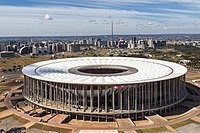
|

|
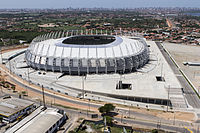
|
| Belo Horizonte, MG | Porto Alegre, RS | ||
| Estádio Mineirão | Estádio Beira-Rio | ||
| Capacity: 62,547
(renovated) |
Capacity: 51,300[40] (renovated)[41] | ||
| File:Novo mineirão aérea.jpg | 
| ||
| Salvador, BA | Recife, PE | ||
| Arena Fonte Nova | Arena Pernambuco | ||
| Capacity: 56,000[42]
(renovated) |
Capacity: 46,154
(new stadium) | ||
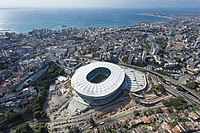
|
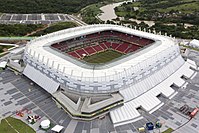
| ||
| Cuiabá, MT | Manaus, AM | Natal, RN | Curitiba, PR |
| Arena Pantanal | Arena Amazônia | Arena das Dunas | Arena da Baixada |
| Capacity: 42,968 (new stadium) Construction progress: 87%[38] |
Capacity: 42,374 (new stadium) Construction progress: 92.83%[38] |
Capacity: 42,086 (new stadium) |
Capacity: 43,981[43] (renovated) Construction progress: 85.5%[38] |

|

|
File:Dunes Arena closer.jpg | File:Baixada Arena closer.jpg |
Final draw
The 32 participating teams were to be drawn into the eight groups of the group stage. In preparation for this, the teams were organised into four pots with the seven highest-ranked teams joining host nation Brazil in the seeded pot.[44] As with the previous tournaments, FIFA aimed to create groups which maximised geographic separation and therefore the unseeded teams were arranged into pots based on geographic considerations.[45][46]
| Pot 1 (seeds) | Pot 2 (Africa & South America) | Pot 3 (Asia & North America) | Pot 4 (Europe) |
|---|---|---|---|
|
|
|
|
The final draw for the 2014 World Cup was held at the Costa do Sauípe Resort, Mata de São João in Bahia on 6 December 2013.[47] The ceremony was presented by FIFA Secretary General Jérôme Valcke and Brazilian hostess Fernanda Lima with the balls being drawn by former players representing the eight past World Cup-winning nations: Cafu, Fabio Cannavaro, Alcides Ghiggia, Fernando Hierro, Geoff Hurst, Mario Kempes, Lothar Matthäus and Zinedine Zidane.[48] During the draw additional draw procedures were applied due to the uneven number of teams within the four geographic pots, which moved one randomly drawn European team from Pot 4 into Pot 2.[49][50] No teams from the same confederation were permitted to be grouped together with the exception of UEFA members, where a maximum of two could be.[45][51]
Refereeing
Match officials



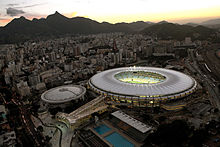

In March 2013, FIFA published a list of 52 prospective referees, each paired with two assistant referees, from all six football confederations for the tournament.[52] On 14 January 2014, the FIFA Referees Committee appointed 25 referee trios and eight support duos representing 43 different countries for the tournament.[53][54]
| Confederation | Referee | Assistants |
|---|---|---|
| AFC | Ravshan Irmatov (Uzbekistan) | Abdukhamidullo Rasulov (Uzbekistan) Bahadyr Kochkarov (Kyrgyzstan) |
| Yuichi Nishimura (Japan) | Toru Sagara (Japan) Toshiyuki Nagi (Japan) | |
| Nawaf Shukralla (Bahrain) | Yaser Tulefat (Bahrain) Ebrahim Saleh (Bahrain) | |
| Ben Williams (Australia) | Matthew Cream (Australia) Hakan Anaz (Australia) | |
| CAF | Noumandiez Doué (Ivory Coast) | Songuifolo Yeo (Ivory Coast) Jean-Claude Birumushahu (Burundi) |
| Bakary Gassama (Gambia) | Evarist Menkouande (Cameroon) Félicien Kabanda (Rwanda) | |
| Djamel Haimoudi (Algeria) | Abdelhalk Etchiali (Algeria) Redouane Achik (Morocco) | |
| CONCACAF | Joel Aguilar (El Salvador) | William Torres (El Salvador) Juan Zumba (El Salvador) |
| Mark Geiger (United States) | Mark Hurd (United States) Joe Fletcher (Canada) | |
| Marco Rodríguez (Mexico) | Marvin Torrentera (Mexico) Marcos Quintero (Mexico) | |
| CONMEBOL | Néstor Pitana (Argentina) | Hernán Maidana (Argentina) Juan Pablo Belatti (Argentina) |
| Sandro Ricci (Brazil) | Emerson De Carvalho (Brazil) Marcelo Van Gasse (Brazil) | |
| Enrique Osses (Chile) | Carlos Astroza (Chile) Sergio Román (Chile) | |
| Wilmar Roldán (Colombia) | Humberto Clavijo (Colombia) Eduardo Díaz (Colombia) | |
| Carlos Vera (Ecuador) | Christian Lescano (Ecuador) Byron Romero (Ecuador) | |
| OFC | Peter O'Leary (New Zealand) | Jan-Hendrik Hintz (New Zealand) Ravinesh Kumar (Fiji) |
| UEFA | Felix Brych (Germany) | Stefan Lupp (Germany) Mark Borsch (Germany) |
| Cüneyt Çakır (Turkey) | Bahattin Duran (Turkey) Tarık Ongun (Turkey) | |
| Jonas Eriksson (Sweden) | Mathias Clasenius (Sweden) Daniel Wärnmark (Sweden) | |
| Björn Kuipers (Netherlands) | Sander van Roekel (Netherlands) Erwin Zeinstra (Netherlands) | |
| Milorad Mažić (Serbia) | Milovan Ristić (Serbia) Dalibor Djurdjević (Serbia) | |
| Pedro Proença (Portugal) | Bertino Miranda (Portugal) Tiago Trigo (Portugal) | |
| Nicola Rizzoli (Italy) | Renato Faverani (Italy) Andrea Stefani (Italy) | |
| Carlos Velasco Carballo (Spain) | Roberto Alonso Fernández (Spain) Juan Carlos Yuste Jiménez (Spain) | |
| Howard Webb (England) | Mike Mullarkey (England) Darren Cann (England) |
| Confederation | Support referee(s) | Support assistant(s) |
|---|---|---|
| AFC | Alireza Faghani (Iran) | Hassan Kamranifar (Iran) |
| CAF | Néant Alioum (Cameroon) | Djibril Camara (Senegal) |
| Daniel Bennett (South Africa) | Aden Marwa (Kenya) | |
| CONCACAF | Roberto Moreno (Panama) | Eric Boria (United States) |
| Walter López (Guatemala) | Leonel Leal (Costa Rica) | |
| CONMEBOL | Víctor Hugo Carrillo (Peru) | Rodney Aquino (Paraguay) |
| OFC | Norbert Hauata (Tahiti) | Mark Rule (New Zealand) |
| UEFA | Svein Oddvar Moen (Norway) | Kim Haglund (Norway) |
Goal-line technology
For the first time at a World Cup Finals, the officials will be assisted by goal-line technology. The previous World Cup was a catalyst for the decision to adopt technology after England were wrongly denied a goal in their Round of 16 tie against Germany.[55] Following the mistake in this game, FIFA President Sepp Blatter said "it would be a nonsense not to reopen the file on goal-line technology"[56] and in 2012 the IFAB approved its usage.[57] This is the fourth FIFA competition to use the technology after successful trials at 2012 Club World Cup, 2013 Club World Cup and 2013 Confederations Cup. The German company GoalControl was selected as the tournament's official goal-line technology provider in October 2013.[58]
Vanishing spray
Following successful trials at the 2013 FIFA U-20 World Cup, 2013 FIFA U-17 World Cup and 2013 FIFA Club World Cup, FIFA approved the vanishing spray to be used by the referees for the first time at a World Cup Finals. The water-based spray, which disappears in a minute after use would be used to mark the ten-yard line for the defending team during a free kick and also drawn where the ball is to be placed for a free-kick.[59]
Squads

As with the 2010 tournament, each team's squad for the 2014 FIFA World Cup will consist of 23 players (three of whom must be goalkeepers). Each participating national association has to confirm their final 23-player squad no later than 10 days before the start of the tournament.
Teams are permitted to make late replacements in the event of serious injury, at any time up to 24 hours before their first game.[60]
Discipline and suspensions
The following players, if included in the final squad of their respective national teams, will be suspended for their team's first match of the tournament for infringements in their final qualification matches.
Subject to FIFA disciplinary judgments, suspensions may be extended to more than one match.[61]
Should either player be omitted from their national squad, the suspension will still be considered 'served' at the tournament.[62]
 Fredy Guarín: sent off vs. Paraguay, serious foul play (double yellow card), 15 October 2013;[63]
Fredy Guarín: sent off vs. Paraguay, serious foul play (double yellow card), 15 October 2013;[63] Mario Mandžukić: sent off vs. Iceland, serious foul play, 19 November 2013;[63]
Mario Mandžukić: sent off vs. Iceland, serious foul play, 19 November 2013;[63] Josip Šimunić: suspended for 10 matches, for using an Ustaše slogan after the Iceland match. This includes playing or attending matches. Šimunić will therefore miss the entire World Cup Finals.[64][65]
Josip Šimunić: suspended for 10 matches, for using an Ustaše slogan after the Iceland match. This includes playing or attending matches. Šimunić will therefore miss the entire World Cup Finals.[64][65]
Matches
The match schedule was announced at FIFA's headquarters in Zürich on 20 October 2011,[66] with the kick-off times being confirmed on 27 September 2012.[67] After the final draw, the kick-off times of seven matches were adjusted by FIFA.[68]
All times listed below are in Brasília official time (UTC−3). This is the time zone of ten of the twelve venues; the other two, Cuiabá and Manaus, are in the Amazon time zone (UTC−4), therefore for matches hosted at these two venues the local kickoff times are one hour earlier than the times listed below.[69]
Group stage
The group winners and runners-up advance to the round of 16.[60]
- Tie-breaking criteria
The ranking of each team in each group will be determined as follows:
- Greater number of points in all group matches
- Goal difference in all group matches
- Greater number of goals scored in all group matches
- Greatest number of points in matches between tied teams
- Goal difference in matches between tied teams
- Greatest number of goals scored in matches between tied teams
- Drawing of lots by the FIFA Organising Committee
| Key to colours in group tables | |
|---|---|
| Teams that advanced to the round of 16 | |
Group A
Template:Fb cl2 header navbar Template:Fb cl2 team Template:Fb cl2 team Template:Fb cl2 team Template:Fb cl2 team |}
| Brazil | Match 1 | |
|---|---|---|
Group B
Template:Fb cl2 header navbar Template:Fb cl2 team Template:Fb cl2 team Template:Fb cl2 team Template:Fb cl2 team |}
| Spain | Match 19 | |
|---|---|---|
| Netherlands | Match 36 | |
|---|---|---|
Group C
Template:Fb cl2 header navbar Template:Fb cl2 team Template:Fb cl2 team Template:Fb cl2 team Template:Fb cl2 team |}
Group D
Template:Fb cl2 header navbar Template:Fb cl2 team Template:Fb cl2 team Template:Fb cl2 team Template:Fb cl2 team |}
| Uruguay | Match 23 | |
|---|---|---|
Group E
Template:Fb cl2 header navbar Template:Fb cl2 team Template:Fb cl2 team Template:Fb cl2 team Template:Fb cl2 team |}
| Ecuador | Match 42 | |
|---|---|---|
Group F
Template:Fb cl2 header navbar Template:Fb cl2 team Template:Fb cl2 team Template:Fb cl2 team Template:Fb cl2 team |}
| Argentina | Match 11 | |
|---|---|---|
Group G
Template:Fb cl2 header navbar Template:Fb cl2 team Template:Fb cl2 team Template:Fb cl2 team Template:Fb cl2 team |}
Group H
Template:Fb cl2 header navbar Template:Fb cl2 team Template:Fb cl2 team Template:Fb cl2 team Template:Fb cl2 team |}
| Belgium | Match 31 | |
|---|---|---|
| South Korea | Match 47 | |
|---|---|---|
Knockout stage
In the knockout stages, if a match is level at the end of normal playing time, extra time shall be played (two periods of 15 minutes each) and followed, if necessary, by kicks from the penalty mark to determine the winner.[60]
| Round of 16 | Quarter-finals | Semi-finals | Final | |||||||||||
| 28 June – Belo Horizonte | ||||||||||||||
| Winner Group A | ||||||||||||||
| 4 July – Fortaleza | ||||||||||||||
| Runner-up Group B | ||||||||||||||
| Winner Match 49 | ||||||||||||||
| 28 June – Rio de Janeiro | ||||||||||||||
| Winner Match 50 | ||||||||||||||
| Winner Group C | ||||||||||||||
| 8 July – Belo Horizonte | ||||||||||||||
| Runner-up Group D | ||||||||||||||
| Winner Match 57 | ||||||||||||||
| 30 June – Brasília | ||||||||||||||
| Winner Match 58 | ||||||||||||||
| Winner Group E | ||||||||||||||
| 4 July – Rio de Janeiro | ||||||||||||||
| Runner-up Group F | ||||||||||||||
| Winner Match 53 | ||||||||||||||
| 30 June – Porto Alegre | ||||||||||||||
| Winner Match 54 | ||||||||||||||
| Winner Group G | ||||||||||||||
| 13 July – Rio de Janeiro | ||||||||||||||
| Runner-up Group H | ||||||||||||||
| Winner Match 61 | ||||||||||||||
| 29 June – Fortaleza | ||||||||||||||
| Winner Match 62 | ||||||||||||||
| Winner Group B | ||||||||||||||
| 5 July – Salvador | ||||||||||||||
| Runner-up Group A | ||||||||||||||
| Winner Match 51 | ||||||||||||||
| 29 June – Recife | ||||||||||||||
| Winner Match 52 | ||||||||||||||
| Winner Group D | ||||||||||||||
| 9 July – São Paulo | ||||||||||||||
| Runner-up Group C | ||||||||||||||
| Winner Match 59 | ||||||||||||||
| 1 July – São Paulo | ||||||||||||||
| Winner Match 60 | Third place | |||||||||||||
| Winner Group F | ||||||||||||||
| 5 July – Brasília | 12 July – Brasília | |||||||||||||
| Runner-up Group E | ||||||||||||||
| Winner Match 55 | Loser Match 61 | |||||||||||||
| 1 July – Salvador | ||||||||||||||
| Winner Match 56 | Loser Match 62 | |||||||||||||
| Winner Group H | ||||||||||||||
| Runner-up Group G | ||||||||||||||
Round of 16
| Winner Group A | Match 49 | Runner-up Group B |
|---|---|---|
| Winner Group C | Match 50 | Runner-up Group D |
|---|---|---|
| Winner Group B | Match 51 | Runner-up Group A |
|---|---|---|
| Winner Group D | Match 52 | Runner-up Group C |
|---|---|---|
| Winner Group E | Match 53 | Runner-up Group F |
|---|---|---|
| Winner Group G | Match 54 | Runner-up Group H |
|---|---|---|
| Winner Group F | Match 55 | Runner-up Group E |
|---|---|---|
| Winner Group H | Match 56 | Runner-up Group G |
|---|---|---|
Quarter-finals
| Winner Match 53 | Match 58 | Winner Match 54 |
|---|---|---|
| Winner Match 49 | Match 57 | Winner Match 50 |
|---|---|---|
| Winner Match 55 | Match 60 | Winner Match 56 |
|---|---|---|
| Winner Match 51 | Match 59 | Winner Match 52 |
|---|---|---|
Semi-finals
| Winner Match 57 | Match 61 | Winner Match 58 |
|---|---|---|
| Winner Match 59 | Match 62 | Winner Match 60 |
|---|---|---|
Third place match
| Loser Match 61 | Match 63 | Loser Match 62 |
|---|---|---|
Final
| Winner Match 61 | Match 64 | Winner Match 62 |
|---|---|---|
Marketing
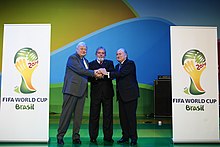
Images, slogan and music
The official logo of the competition is entitled "Inspiration", and was created by Brazilian agency Africa.[70] The design is based around a photograph of three victorious hands together raising the World Cup trophy and its yellow and green colouring is meant to represent Brazil warmly welcoming the world to their country. It was unveiled at a ceremony held during the 2010 World Cup in Johannesburg.[70] The design was selected from the submissions of 25 Brazilian-based agencies invited to submit designs.[71] Brazilian graphic designer Alexandre Wollner has criticised the design, suggesting that it resembles a hand covering a face in shame, as well as the process through which it was chosen, which had a jury that excluded professional graphic designers.[72]
FIFA also commissioned an official poster that was unveiled in January 2013 and designed by the Brazilian creative agency Crama.[73] The official slogan is "All in One Rhythm" (Portuguese: "Juntos num só ritmo").[74]
An official song has been created for every World Cup finals since 1962. On 24 January 2014, FIFA and Sony Music announced that the official anthem for the tournament will be "We Are One" by Pitbull, Jennifer Lopez and Claudia Leitte.[75] Sony has also launched a global music contest – entitled 'SuperSong' – to select a song for the competition's official album.[76] The contest allows any person to submit a song via a website, with the winning entrant chosen in February 2014 to be professionally recorded by the singer Ricky Martin.[76] On 10 February 2014, American Elijah King was chosen with the song "Vida" ("Life", in English).[77]
In addition to composed songs, the tournament also recognises an official instrument: The caxirola, a percussive instrument created by Brazilian musician Carlinhos Brown.[78] They are designed to create a softer sound than the African vuvuzela horn that featured prominently during the 2010 World Cup. However, due to safety concerns, FIFA later announced that caxirolas will not be permitted inside the stadiums.[79]
Video game
As with the 2010 tournament, EA Sports will publish the official video game of the competition, entitled 2014 FIFA World Cup Brazil.[80] It is expected to be released in April 2014.[81]
Mascot
The tatu-bola, an armadillo that defends itself from predators by rolling up into a ball, was chosen as the official mascot by FIFA at a ceremony organised by the local organising committee in September 2012.[82] It was selected from 47 designs created by six Brazilian agencies after market research showed its appeal to the primary target audience of Brazilian children aged 5–12.[83]
The then-unnamed mascot was first unveiled to the public during a segment of the Brazilian news show Fantástico.[84] An online public vote was used to determine the name in which three potential names were offered,[85] with the winning name being announced on 25 November 2012:[86] 1.7 million people (about 48 per cent) voted for Fuleco, ahead of Zuzeco (31 per cent) and Amijubi (21 per cent).[87]
"Fuleco" is a portmanteau of the words "Futebol" ("Football") and "Ecologia" ("Ecology") (in addition, nicknames ending with -eco are popular in Brazil). The two unsuccessful names were Amijubi ("Amizade" ("Friendship") and "Júbilo" ("Joy")) and Zuzeco ("Azul" ("blue") and "Ecologia").[86]
Match ball
The official ball of the 2014 World Cup will be the Adidas Brazuca.[88] The name was selected by a public vote that received responses from more than 1 million Brazilian football fans; "Brazuca" received over 70 per cent of the vote.[89] Adidas, the official FIFA World Cup match ball supplier since 1970, took inspiration from elements of Brazilian culture to come up with a shortlist of three possible names for the ball that also included Bossa Nova and Carnavalesca.[89]

Sponsorship
The sponsors of the 2014 World Cup are divided into three categories: Fifa Partners, FIFA World Cup Sponsors and National Supporters.[90]
| FIFA partners | FIFA World Cup sponsors | National supporters |
|---|---|---|
|
Preparations
In January 2010 Brazil's federal government estimated that staging the tournament would require it invest $11 billion of funding.[91] It also announced tax breaks for the construction and refurbishment of the stadiums for the 2014 World Cup and that host cities would be exempt from VAT.[92]
Infrastructure projects

The airports in Brazil have been identified as "the big problem" by the tournament's organising committee.[93] An estimated 600,000 people will travel by plane to the tournament in addition to three million Brazilians using flight to travel between matches.[94]

Legislation was introduced to enable the state's airport operator Infraero to speed up airport works.[95] However, research by the Brazilian government in 2011 forecast that 10 of the 13 terminals to be upgraded were unlikely to be completed in time for the tournament.[96] Brazilian President Dilma Rousseff stated that the government would make "a strong intervention" to ensure that the airports are ready, including opening them up to private investment.[96] To date, the management of three airports has already been handed over to the private sector (earning $10.8 billion),[97] with two further auctions planned before the end of 2013.[98]
Additional major infrastructure projects have been taking place across the country on road systems and light rail and bus rapid transit lines that will connect the airports to the city centres and stadiums. Over 4,300 km of highways will need to be worked on.[99] Media reports however speculate that some of these transport links will not be completed in time for the tournament.[100][101] Over $5 billion is also being invested to build new hotels ready for both the World Cup Finals as well as the 2016 Summer Olympics to be staged in Rio de Janeiro.[102]
A reported 13 of the original 50 planned infrastructure works announced by the Brazilian sports ministry in 2010 have already been cancelled.[103] New projects subsequently introduced were smaller in scale to those originally proposed.[103] Former Brazilian footballer Romário, now a political figure, criticised his country's handling of these preparations but said that "FIFA's requirements were excessive".[104]
Security measures
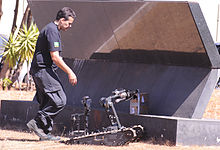
The Brazilian government has pledged $900 million will be invested into security forces and that the tournament will be "one of the most protected sports events in history".[105] FIFA Secretary General Jérôme Valcke promised "the highest level of security you can imagine" will operate during competition.[105] It plans to have one police officer for every 50 people attending matches, and one for every 80 people at public viewing events around the country.[105]
Investment in security measures such as facial recognition systems and unmanned security robots has already been made.[106] An integrated security plan has been developed that seeks to gain information from sources about potential terrorists, troublemakers and hooligans.[107] A total of 150,000 public security professionals and military will ensure World Cup security, alongside with 20,000 private security personnel.[108]
Security concerns for the tournament have been increased since large-scale protests occurred during Brazil's staging of the 2013 FIFA Confederations Cup with disturbances also occurring outside the stadiums.[109][110] Protesters cited the amount of public money being invested by the Brazilian government in the hosting of the World Cup at the expense of social services for its population as a key grievance.[111][112][113]
Ticketing
FIFA forecasts a total of 3,334,524 tickets for the tournament.[114] The majority of these are distributed to groups such as commercial affiliates, hospitality clients, media rights holders and VIPs.[114] Approximately 1.1 million are to be sold to the general public (400,000 to Brazilian residents only, 700,000 overseas and Brazilians).[114]
The sale of tickets to the general public has been divided into three phases and handled via FIFA's website and nominated locations in each of the host cities.[115][116] There are four categories of tickets, with Category 4 tickets only being available to Brazilian residents.[114] Discounted tickets are available to Brazilians aged over 60, students and those receiving Bolsa Família welfare.[114] These are available for as little as 30 Brazilian reals (roughly US$12.50), while the most expensive ticket of the competition on general sale is a Category 1 seat for the final that retails at US$990.[114] In addition to individual tickets "venue specific tickets", which give access to all matches staged in a host city (during the group stage and round of 16), and "team ticket series", which give access to all matches of a chosen team during the tournament, are also available.[114]
Tickets went on sale on 20 August 2013 with 2.3 million tickets requested during the first 24 hours.[117] By the end of this first phase of sales in October 2013, over six million requests had been received from the general public.[118] As demand exceeded supply, FIFA staged a random draw to allocate tickets with a total of 889,305 tickets being allocated: 71.5% of these were sold to Brazilian residents with the highest number of overseas sales being to those in the United States.[119] A further 220,000 tickets issued on a first come, first served basis sold out within seven hours of being placed on sale in November 2013.[120][121] A second phase of ticket sales – to run until 30 January – began following the final draw in December 2013, which yielded almost 1.2 million ticket requests within the first 24 hours.[122]
Media

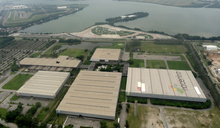
Filming
Sony will supply the technology for filming of the games. The games will be produced for FIFA by Host Broadcast Services, subsidiary of Infront Sports & Media. FIFA TV Director Niclas Ericson confirmed that the games will be filmed at Ultra HDTV technology (4K resolution). The announcement followed a successful test of the tech at 2013 FIFA Confederations Cup, with the sport's governing body FIFA ready to take the plunge for the showcase game in Brazil.[123]
The multilateral camera plan for the games includes coverage by the inclusion of a cable system and an aerial (helicopter) camera for all matches. An up to 34-camera plan has been proposed, with two new reverse-angle 6m cameras – SSM and mainly used for replays – bringing the number up from the 32 used in 2010.[124]
Broadcasting
The broadcasting rights – covering television, radio, internet and mobile coverage – for the tournament are sold to media companies in each individual territory either directly by FIFA, or through licensed companies or organisations such as the European Broadcasting Union, Organización de Televisión Iberoamericana, International Media Content, Dentsu and RS International Broadcasting & Sports Management.[125] The sale of these rights accounts for an estimated 60% of FIFA's income from staging a World Cup.[126] For a fourth consecutive FIFA World Cup Finals, the coverage will be provided by HBS (Host Broadcast Services),[127] in partnership with Sony as the production equipment supplier.[128] The International Broadcast Centre will be situated at the Riocentro in Rio de Janeiro.[129]
The International Broadcast Centre for these games will be located at the Riocentro exhibition complex in the Barra da Tijuca neighbourhood of Rio de Janeiro.
FIFA Fan Fest
Due to the overwhelming success of the 2010 edition, FIFA announced that they would be holding FIFA Fan Fests in each of Brazil's 12 host cities. Prominent examples are the Copacabana Beach in Rio de Janeiro, which already held a Fan Fest in 2010, São Paulo's Vale do Anhangabaú and Brasília's Esplanada dos Ministérios, with the Congress in the background.[130][131]
Locations

Places by Brazilian cities:[132]
- Rio de Janeiro – Praia de Copacabana (Copacabana Beach)
- Sao Paulo – Vale do Anhangabaú (Anhangabaú Valley)
- Brasília – Esplanada dos Ministérios (Esplanade of Ministries)
- Belo Horizonte – Praça da Estação (Square of Station)
- Cuiabá – Parque de Exposições (Exhibitions Park)
- Curitiba – Parque Barigui (Barigui Park)
- Fortaleza – Praia de Iracema (Iracema Beach)
- Manaus – Memorial Encontro das Águas (Memorial Meeting of the Waters)
- Natal – Praia do Forte (Strong Beach)
- Porto Alegre – Praça Glênio Peres (Glenio Peres Square)
- Recife – Marco Zero (Zero Mark)
- Salvador – Praia do Jardim de Alah (Garden of Allah Beach)
Development programme
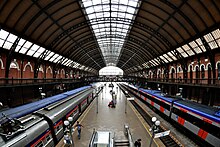
The Brazilian federal government has earmarked R$3 billion (€1.8 billion, £1.1 billion) for investment in works relating to the 2014 World Cup, and intends to release a package of works, entitled the FIFA World Cup PAC (Portuguese acronym for Growth Acceleration Programme). According to the Brazilian minister of cities, Márcio Fortes, the bulk of funds should go to works pertaining to the tournament itself, but the total figure will only be defined after a meeting with representatives of the municipalities that will host the matches.
"This is only an initial figure. We have not set a figure yet. These R$3 billion will allow us to take the first step. The total value of projects is not known yet. We are going to hold talks with mayors to learn which projects are priorities," said the minister. The funds will be supplied by Pró-Transporte, a financing programme funded by the Severance Pay Indemnity Fund (FGTS) whose regulation was passed last year by the fund's Board of Curators.
According to Fortes, several city councils have already contacted the ministry and showed interest in partnership for carrying out infrastructure work turned exclusively to the Cup that will be held in Brazil. "For some time now, the city councils that will host the matches have been contacting us. The city councils have had meetings with FIFA and several projects were outlined. Our approach consists of dealing only with projects exclusively turned to the Cup. Our goal right now is not to solve transport-related issues in the city. We are going to help solve the issues pertaining to the events," he stated. According to the minister, another factor to be analysed by the Ministry of Cities is usefulness and sustainability of the investment after the competition is over. "We are not going to deal with huge projects. The cheapest and most efficient means of transport will be used. Of course, each case will be analysed separately," he explained.
Fortes stated that the PAC of the Cup is going to include partnerships with city councils and state governments, as well as some partnerships with the private sector. "The keyword is partnership. The federal government will not undertake anything by itself. It will be similar to the infrastructure PAC, in which we already have partnerships with city councils and state governments, as well as public-private partnerships. We are going to review the type of investment proposed, analyse their size, and the need for private sector participation, which may take place in different ways. The private sector may build and then lease the assets, or perhaps operate them. All of that will be discussed," he stated.
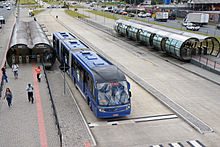


The minister also informed that preparations for the World Cup already include the creation of a line of financing for renewing the bus fleet across the country. The line will be made available by the Brazilian Federal Savings Bank with total funds of R$1 billion (€600 million, £375 million).[133]
To support the sport's development throughout the continent leading up to the World Cup, FIFA as part of its "Win in CONMEBOL with CONMEBOL" program, has invested in building synthetic football pitches in each country within the confederation. The football turf pitch in Brazil is located at the CBF national training center in Rio de Janeiro and built by a FIFA Preferred Producer for Football Turf.
Maracanã projects
Maracanã Stadium, in the city of Rio de Janeiro, has been chosen for the final match. Maracanã was inaugurated in the 1950 World Cup. For the 2014 World Cup, among other adaptations, a new cover will be built. The project also includes construction of a building for parking, above the lines of Supervia and subways, with 3,500 parking spaces. The estimated investment is R$460 million. According to the study of Sinaenco, there is a need to improve the visibility for spectators in the first few rows behind the cabins in the Maracanã, redesign the facilities for people with disabilities, and provide general health reform.
The project may also provide for the restoration of Quinta da Boa Vista and the Museum of São Cristóvão, in addition to redevelopment and revitalisation of neighbourhoods including Tijuca. The Engenhão stadium, completed for the 2007 Pan American Games, has a capacity of 45,000 people and will serve as a training ground for the World Cup.
An investment of R$5 billion is required to meet the requirements that Rio de Janeiro faces in the final tournament and other games, covering three areas: logistics (roads, railways, ports, waterways and airports), energy (generation and transmission of electric power, petroleum, natural gas and renewables) and social and urban (light, sanitation, housing, subways and water resources). In relation to the Rio de Janeiro Metro, the Ministry of Transport has held a public hearing regarding the extension of its lines. The line for the new project is 13.5 km (8.4 mi) long, and should cross the South Zone of the city, carrying around 200,000 passengers per day between six metro stations.[134]
Corinthians projects
The New Corinthians Stadium, in the city of São Paulo, has been chosen for the opening ceremony. São Paulo's chances of staging the opening ceremony of the 2014 FIFA World Cup improved after FIFA accepted a guarantee that SC Corinthians Paulista's new stadium will be completed in time for the tournament. The stadium, being built by Odebrecht SA, will cost R$800 million (US$522 million), according to Corinthians former President Andres Sanchez. BNDES, the national development bank, pledged R$400 million and the city of São Paulo will provide a property fund worth R$400 million.
On a statement on the Corinthians website, Ricardo Teixeira, president of the World Cup local organising committee and the Brazilian Football Confederation, said: "This approval – in record time, less than a year – is the result of efforts by the government of São Paulo, particularly the Governor Geraldo Alckmin and Mayor Gilberto Kassab."[135] FIFA's approval of the project to build a new home for Brazil's biggest football club by revenue, which originally had a cost estimate of US$1.2 billion, was required for São Paulo to host World Cup games.
In June 2011, then sports minister Orlando Silva said in an interview that the federal government would tell tournament organiser FIFA that São Paulo, Salvador, Belo Horizonte and Brasília are eligible to stage the opening ceremony. FIFA will announce the venue in October. Sanchez said: "I said before that if Corinthians could fulfill all the requirements of FIFA, the opening of the World Cup would be in São Paulo. Corinthians gave the guarantees required by FIFA, so the opening will be in São Paulo."[135] Most of the funding for investment in airports, stadiums, ports and urban transportation before the World Cup will come from the government.[135]
Notes
- ^ The Portuguese pronunciation is [ˈkɔpɐ du ˈmũdu dɐ ˈfifɐ bɾɐˈziw ˈdojz ˈmiw i kɐˈtoʁzi], in Brazil's standard pronunciation.
References
- ^ "Pot allocations for the Preliminary Draw". FIFA. 27 July 2011. Retrieved 27 July 2011.
- ^ "FIFA launch GLT tender for Brazil 2013/14". FIFA. 19 February 2013.
- ^ "If the World Cup started tomorrow". ESPN. 12 June 2013.
- ^ "2014 FIFA World Cup to be held in South America". FIFA. 7 March 2003.
- ^ "Rotation ends in 2018". FIFA. 29 October 2007.
- ^ "Argentina, Brazil and Colombia want 2014 World Cup". People's Daily. 19 January 2003.
- ^ "Brazil set to host World Cup". BBC. 18 March 2003.
- ^ "Colombia bids for 2014 World Cup". BBC. 17 July 2006.
- ^ "Colombia join 2014 World Cup race". BBC. 19 December 2006.
- ^ "Brazil to make 2014 World Cup bid". BBC. 13 December 2006.
- ^ "Brazil confirms bid – Colombia withdraws". FIFA. 13 April 2007.
- ^ "Brazil confirmed as 2014 hosts". FIFA. 30 October 2007. Archived from the original on 31 October 2007. Retrieved 30 October 2007.
- ^ "Financial report presented, Brazil 2014 slots & host countries decided". FIFA. 3 March 2011.
- ^ "Rio draw pits Spain against France". FIFA. 30 July 2011. Retrieved 28 March 2013.
- ^ "Draw for World Cup qualifiers at Marina da Glória in Rio" (in Portuguese). globoesporte.com. 8 December 2010. Retrieved 21 January 2011.
- ^ "Barbarez: The World Cup is priceless". FIFA. 16 October 2013.
- ^ "Portugal climbs to 5th in FIFA Ranking". Goal.com. 28 November 2013.
- ^ "World Cup seeds to be based on October world ranking". Espn Fc. 4 October 2013. Retrieved 12 January 2014.
- ^ "FIFA's Inspection Report" (PDF). Retrieved 9 October 2011.
- ^ "Host cities – World Cup". BBC News. 31 May 2009.
- ^ "Host Cities for Brazil 2014 to be announced in May". FIFA. 12 March 2009. Retrieved 7 September 2013.
- ^ "Host cities in 1950 FIFA World Cup". Colunas.globoesporte.com. Retrieved 9 October 2011.
- ^ "2014 Fifa World Cup: Luck of the draw 'an essential component'". BBC. 2 December 2013.
- ^ "Price tag rises for Brazil's World Cup stadiums". Goal.com. 28 November 2013.
- ^ "2014 Fifa World Cup: Where are the 12 host stadiums in Brazil?". BBC. 3 December 2013.
- ^ "Sao Paulo dropped for 2014". SBS. 17 June 2010. Archived from the original on 28 June 2010. Retrieved 17 June 2010.
{{cite web}}: Unknown parameter|deadurl=ignored (|url-status=suggested) (help) - ^ "Brazil's first 2014 World Cup stadium holds matches". NewVision. 28 January 2013. Retrieved 30 January 2013.
- ^ "Brazil's Fortaleza Becomes First World Cup City To Deliver Finished Stadium". SportsBusinessDaily. 3 May 2013.
- ^ "Fortaleza first city to strike World Cup goal for Brazil". Financial Times. 2 May 2013.
- ^ "Destination: Stadiums". FIFA. 15 June 2013.
- ^ "Brazil World Cup: Six stadiums to miss Fifa deadline". BBC. 5 December 2013.
- ^ "Two die in Brazil World Cup stadium accident". BBC. 27 November 2013.
- ^ "World Cup venue in southern Brazil in danger of not being ready; FIFA's Valcke gives ultimatum". Fox News Channel. Retrieved 22 January 2014.
- ^ "Curitiba to stay as World Cup venue in Brazil | Football News". ESPN.co.uk. 26 September 2011. Retrieved 19 February 2014.
- ^ "Estádio Nacional Mané Garrincha". FIFA. Retrieved 14 June 2013.
- ^ "Estadio do Maracana – Rio De Janeiro". FIFA. Retrieved 2 June 2013.
- ^ "Fifa admite adotar nome Mané Garrincha em estádio de Brasília na Copa". Copadomundo.uol.com.br. 6 May 2013. Retrieved 20 June 2013.
- ^ a b c d Cite error: The named reference
estadaowas invoked but never defined (see the help page). - ^ "Estadio Castelao – Fortaleza". FIFA. Retrieved 20 June 2013.
- ^ "Site oficial do Sport Club Internacional – Projeto Gigante Para Sempre". Internacional.com.br. Retrieved 25 May 2013.
- ^ http://www.fifa.com/worldcup/news/newsid=2281119/index.html
- ^ "Arena Fonte Nova – Salvador Stadium". FIFA. 28 January 1951. Retrieved 20 June 2013.
- ^ "Arena da Baixada's capacity". Globoesporte.globo.com. 30 July 2013. Retrieved 16 September 2013.
- ^ "Pot 1 seeds set for Brazil 2014 draws". FIFA. 17 October 2013. Retrieved 23 November 2013.
- ^ a b "Draw procedures approved". FIFA. 3 December 2013. Retrieved 3 December 2013.
- ^ "Final draw procedures" (PDF). FIFA. 3 December 2013. Retrieved 3 December 2013.
- ^ "Final Draw". FIFA. Retrieved 15 October 2013.
- ^ "Final Draw reveals intriguing groups". FIFA. 6 December 2013. Retrieved 6 December 2013.
- ^ "The Final Draw: your questions answered". FIFA. 4 December 2013. Retrieved 4 December 2013.
- ^ "Final Draw – Live commentary". FIFA. 6 December 2013. Retrieved 6 December 2013.
- ^ Farley, Richard (3 December 2013). "2014 FIFA World Cup Draw: Here's how it's going to work". NBC Sports. Retrieved 7 December 2013.
- ^ "Open list of prospective referees & assistant referees for the 2014 FIFA World Cup" (PDF). FIFA. 7 March 2013.
- ^ "Referee trios and support duos appointed for 2014 FIFA World Cup". FIFA. 15 January 2014.
- ^ "Referees & Assistant referees for the 2014 FIFA World Cup" (PDF). FIFA. 14 January 2014.
- ^ "England v Germany: Frank Lampard denied goal by Uruguayan linesman – in pictures". The Daily Telegraph. 27 June 2010.
- ^ "World Cup 2010: Blatter apologises for disallowed goal". BBC Sport. 29 June 2010.
- ^ "IFAB gives the green light to goal-line technology". FIFA. 5 July 2012.
- ^ "GoalControl confirmed as goal-line technology provider for Brazil 2014". FIFA. 10 October 2013.
- ^ "Vanishing spray set for World Cup". eurosport.com. 21 November 2013.
- ^ a b c "Regulations – FIFA World Cup Brazil 2014" (PDF). FIFA.
- ^ FIFA disciplinary judgments Template:En icon
- ^ Suspension – FIFA Template:En icon
- ^ a b 2014 FIFA World Cup Template:En icon
- ^ "Croatian player sanctioned for discriminatory behaviour". FIFA. 16 December 2013. Retrieved 16 December 2013.
- ^ "Croatia defender Josip Simunic to miss World Cup for pro-Nazi chant – Independent.ie". Irish Independent. 16 December 2013. Retrieved 16 December 2013.
- ^ "Match schedule for 2014 FIFA World Cup unveiled". FIFA. 20 October 2011.
- ^ "FIFA Executive Committee approves kick-off times for Brazil 2014". FIFA. 27 September 2012.
- ^ "Match schedule for Brazil 2014 confirmed". FIFA. 7 December 2013.
- ^ "MATCH SCHEDULE – 2014 FIFA World Cup Brazil" (PDF). FIFA.
- ^ a b "Re-live the Brazil 2014 Emblem Launch". FIFA. 7 July 2010.
- ^ Shanahan, Mark; Goldstein, Meredith (10 July 2010). "Gisele picks logo, shops with Tom". Boston Globe. Archived from the original on 11 July 2010. Retrieved 11 July 2010.
{{cite news}}: Unknown parameter|deadurl=ignored (|url-status=suggested) (help) - ^ "Designer critica logo da Copa 2014: "É uma porcaria" – Terra – Esportes". deportesus.terra.com.br. 9 July 2010. Archived from the original on 9 July 2010. Retrieved 6 December 2013.
{{cite web}}:|archive-date=/|archive-url=timestamp mismatch; 12 July 2010 suggested (help); Unknown parameter|deadurl=ignored (|url-status=suggested) (help) - ^ "2014 Ambassadors unveil Official Poster". FIFA. 30 January 2013.
- ^ "Brazil 2014 slogan presented: All in one rhythm™ / Juntos num só ritmo". FIFA. 30 May 2012.
- ^ Rusu, Dragos (24 January 2014). "Pitbull's "We Are One" Collaboration Named as Official 2014 World Cup Anthem". Softpedia. Retrieved 24 January 2014.
- ^ a b "Music hopefuls invited to add to the rhythm of the 2014 FIFA World Cup". FIFA. 15 November 2013.
- ^ "Ricky Martin's World Cup Song Written By Elijah King; Salaam Remi to Produce". Billboard. 10 February 2014. Retrieved 11 February 2014.
- ^ "Caxirolas: The Vuvuzelas of 2014 FIFA World Cup in Brazil". Fifa2014wiki.com. Retrieved 20 June 2013.
- ^ "Police ban Brazilian vuvuzelas". Fox Sports. 10 May 2013.
- ^ Ivan, Tom (30 October 2013). "EA confirms FIFA 2014 World Cup game". GamesRadar. Retrieved 14 December 2013.
- ^ "EA SPORTS Launches 2014 FIFA World Cup Brazil this April". 6 February 2014. Retrieved 8 February 2014.
- ^ "Fifa registra desenho e confirma tatu-bola como mascote da Copa" (in Portuguese). Globoesporte.com. 11 September 2012. Retrieved 11 September 2012.
- ^ "Armadillo alert: Official Mascot introduced to the world". FIFA. 17 September 2012.
- ^ "2014 Mascot is big in Brazil".
- ^ "Official Mascot Launc – Q&A" (PDF).
- ^ a b "Fuleco é escolhido como nome do mascote da Copa de 2014". UOL Esporte (in Portuguese). São Paulo. 26 November 2012. Retrieved 26 November 2012.
- ^ "Fuleco wins name game". FIFA. 26 November 2012.
- ^ "World Cup 2014 Brazuca". Soccer.com/Guide. Soccer.com. Retrieved 28 October 2013.
- ^ a b "adidas Brazuca – Name of Official Match Ball decided by Brazilian fans". FIFA. 2 September 2012. Retrieved 3 September 2012.
- ^ "2014 FIFA World Cup Brazil official partners". FIFA. Retrieved 12 January 2014.
- ^ "Swiss Re Says Brazil Spending for World Cup, Olympics Means More Revenue". Bloomberg L.P. 8 April 2010.
- ^ "Brazil shall grant tax breaks for 2014 stadiums". Portal 2014. 18 May 2010. Retrieved 30 October 2007.
- ^ "Airports: the headache of the 2014 World Cup". CONMEBOL.com. 15 April 2013.
- ^ "Poor travel options to test 600,000 foreign fans who flock to Brazil for World Cup". Fox Sports. 3 December 2013.
- ^ "Law reduces bureaucracy of airports building". v-brazil.com. 8 June 2010.
- ^ a b "Brazil's airports 'not ready for World Cup 2014'". BBC. 15 April 2011.
- ^ "Airport auction tests readiness for World Cup: Corporate Brazil". Bloomberg. 19 November 2013.
- ^ "Brazil's Infraero delayed on World Cup airports, Globo reports". Bloomberg. 22 September 2013.
- ^ "Sustainable Brazil: Social & Economic Impacts of the 2014 World Cup" (PDF). Ernst & Young. 2011. p. 13.
- ^ "VLT linha 1-trecho 1 (Aeroporto/Terminal Asa Sul)" (in Portuguese). Retrieved 5 October 2012.
- ^ "VLT Cuiabá/Várzea Grande" (in Portuguese). Retrieved 5 October 2012.
- ^ "422 Hotels to be built in Brazil ahead of 2016 Olympics". Fox News Channel. 22 November 2013.
- ^ a b "Promessa da Copa de melhorar mobilidade urbana não será cumprida" (in Portuguese). apublica.org. 24 January 2013.
- ^ "The social cost of Brazil hosting World Cup 2014". Bleacher Report. 6 June 2013.
- ^ a b c "Brazil boosts World Cup security budget as crime rises". CNN. 5 December 2013.
- ^ "Brazil going to use robots to help with 2014 World Cup security". Brazil My Country. 15 May 2013. Retrieved 15 May 2013.
- ^ "Integration is the keyword in the Strategic Security Plan". World Cup Portal. 14 September 2009.
- ^ Brazil's massive World Cup security forces
- ^ "Brazil Maracana stadium protest ends in clashes". BBC News. 16 June 2013.
- ^ "Brazil unrest: 'Million' join protests in 100 cities". BBC News. 21 June 2013.
- ^ "Brazil's protests raise fears for World Cup as a million take to the streets". The Guardian. 21 June 2013.
- ^ "World Cup only benefits outsiders, say Brazil protesters". CNN. 19 June 2013.
- ^ "In the favelas on the frontline of protest, Brazilians ask: who is this World Cup for?". The Guardian. 22 June 2013.
- ^ a b c d e f g "Ticket media information" (PDF). FIFA. Retrieved 6 December 2013.
- ^ "Sales phases". FIFA. 20 August 2013.
- ^ "FIFA Venue Ticketing Centre Locations". FIFA. 20 August 2013.
- ^ "2.3 million tickets for the FIFA World Cup requested in the first 24 hours of sales". FIFA. 22 August 2013.
- ^ "Tickets for Brazil 2014 in heavy demand". FIFA. 10 October 2013.
- ^ "889,305 tickets allocated during the random selection draw for the 2014 FIFA World Cup". FIFA. 5 November 2013.
- ^ "Second ticketing sales window now open". FIFA. 8 November 2013.
- ^ "No more 2014 FIFA World Cup tickets available in second sale period after seven hours". FIFA. 11 November 2013.
- ^ "Almost 1.2 million FIFA World Cup tickets requested in the first 24 hours of sales". FIFA. 9 December 2013.
- ^ "Next year's World Cup Final will be shot and broadcast in 4K". Retrieved 13 January 2014.
- ^ "2014 World Cup in Brazil- Overview". HBS.tv. Retrieved 13 January 2014.
- ^ "2014 FIFA World Cup BrazilTM Media Rights Licensees" (PDF). FIFA. 7 November 2013.
- ^ "FIFA revenue estimated to be 4 billion dollars at the close of the 2014 World Cup". CONMEBOL.com. 17 May 2013.
- ^ "Host Broadcasting". FIFA. Retrieved 4 December 2013.
- ^ "Sony Professional awarded 2014 FIFA World Cup Broadcast Production Contract". Live-production.tv. 13 September 2012.
- ^ "International Broadcast Centre to be hosted in Rio de Janeiro". FIFA. 27 May 2011.
- ^ "World Cup 2014 FanCamps and FanFests". Retrieved 8 August 2012.
- ^ "FIFA Fan Fest locations confirmed". Retrieved 20 January 2014.
- ^ Fifa divulga locais dos Fan Fests da Copa de 2014 Template:Pt icon
- ^ "Brazil-Arab news Agency – World Cup". .anba.com.br. Retrieved 9 October 2011.
- ^ "Rio and the final match of 2014 FIFA World Cup". Copa2014.org.br. Retrieved 9 October 2011.
- ^ a b c "Sao Paulo Hopes of Hosting 2014 FIFA World Cup Opening Ceremony Boosted". Sportconnect. 14 July 2011. Retrieved 22 October 2011.

